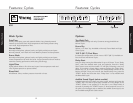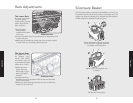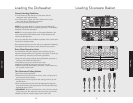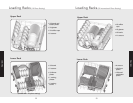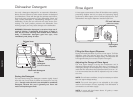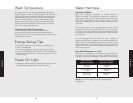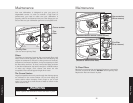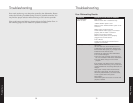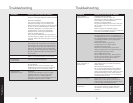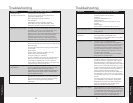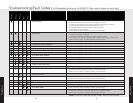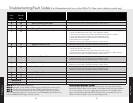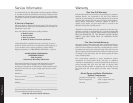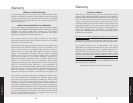
33
Product Care
32
Product Care
Troubleshooting
PROBLEM POSSIBLE CAUSE AND/OR REMEDY
Spotting and filming No rinse agent:
Does the rinse agentdispenser needto be filled?
Dishwasher detergent:
Use only the correct amount of dishwasher
detergent according to the hardness of the
water and the wash program you have selected.
Do not use old or caked detergent. Store the
dishwasher detergent in a dry place and in a
closed container. Change the dishwasher
detergent if the result is still unsatisfactory.
Items not loaded properly:
Check that you loaded the items according to
the instructions on pages in this manual. Do not
overload. Make sure water can reach all soiled
surfaces.
Dishes are not clean Check that both wash arms can rotate freely
and that items do not obstruct the movement
of the wash arms. Lift the arms and make sure
that no grains of dirt retard the rotation of the
wash arms. If necessary, clear the obstruction,
refit the arms, and check that they rotate freely.
Be sure a utensil or handle has not prevented
their turning.
Strainer blocked Check the strainer. Clean if necessary.
Refer to maintenance section in this manual.
Excessive foam Use only dishwasher detergent.
in the machine
Marks and discoloration Aluminum utensils rubbing against items
during washing:
Be sure aluminum utensils, especially light
weight foil-type pans, do not touch dishes.To
remove spots, use a non-abrasive cleaner.
Small particles Detergent:
deposited on items Use only fresh detergent. Store in a tightly
closed container in a cool dry place. Fill
dispenser only when ready to start the
dishwasher. Use the recommended amount of
detergent, especially with hard water.
Troubleshooting
PROBLEM POSSIBLE CAUSE AND/OR REMEDY
Small particles Improper loading of dishes:
deposited on items Load dishes to prevent water and
detergent from being trapped in or between
items. Water should circulate freely.
Flatware incorrectly loaded:
Pay particular attention to spoons so that they
do not nest in each other and prevent water
penetration.
Make sure filters are installed properly.
Filter may have clogged due to heavy sediment,
food soil or hard water conditions.
Yellow or brown marks Iron or manganese in water:
Temporary solution: Pour in one teaspoon to
one tablespoon of citric acid crystals instead of
the prewash detergent. Follow this prewash with
a full detergent wash. Use the pots/pans or
normal wash cycle.
Permanent solution: Install an iron
removal system in the water supply.
Copper with sterling silver:
Yellow film on sterling silver results when
washing copper items in the same load. Silver
polish usually removes the stain.
Tea or coffee (tannic acid):
Tea or coffee can stain cups. Remove stains
by hand, using a solution of 1/2 cup bleach
and 3 cups warm water. (Do not use on
sterling silver or silverplate.)
Discoloration of stainless Allowing salty foods to remain on flatware
steel, silverplate, or Rinse flatware that is to stand several hours
sterling silver before washing.
Stainless steel contacting silver:
Do not put stainless steel and silver flatware
in the same silverware basket compartment.
Direct contact between these metals can cause
permanent damage to silver. Clean stained
items with silver polish. Do not use abrasives
on stainless steel or silver.
Distortion of plastics Plastic items have a low heat tolerance:
Plastics vary in their ability to tolerate heat.
Check washing instructions for all plastic items
to be sure they are dishwasher safe.
Marks on melamine Porous material:
and plastics Use a special cleaner for plastic. DO NOT
use bleach or scouring powder on these
materials.



